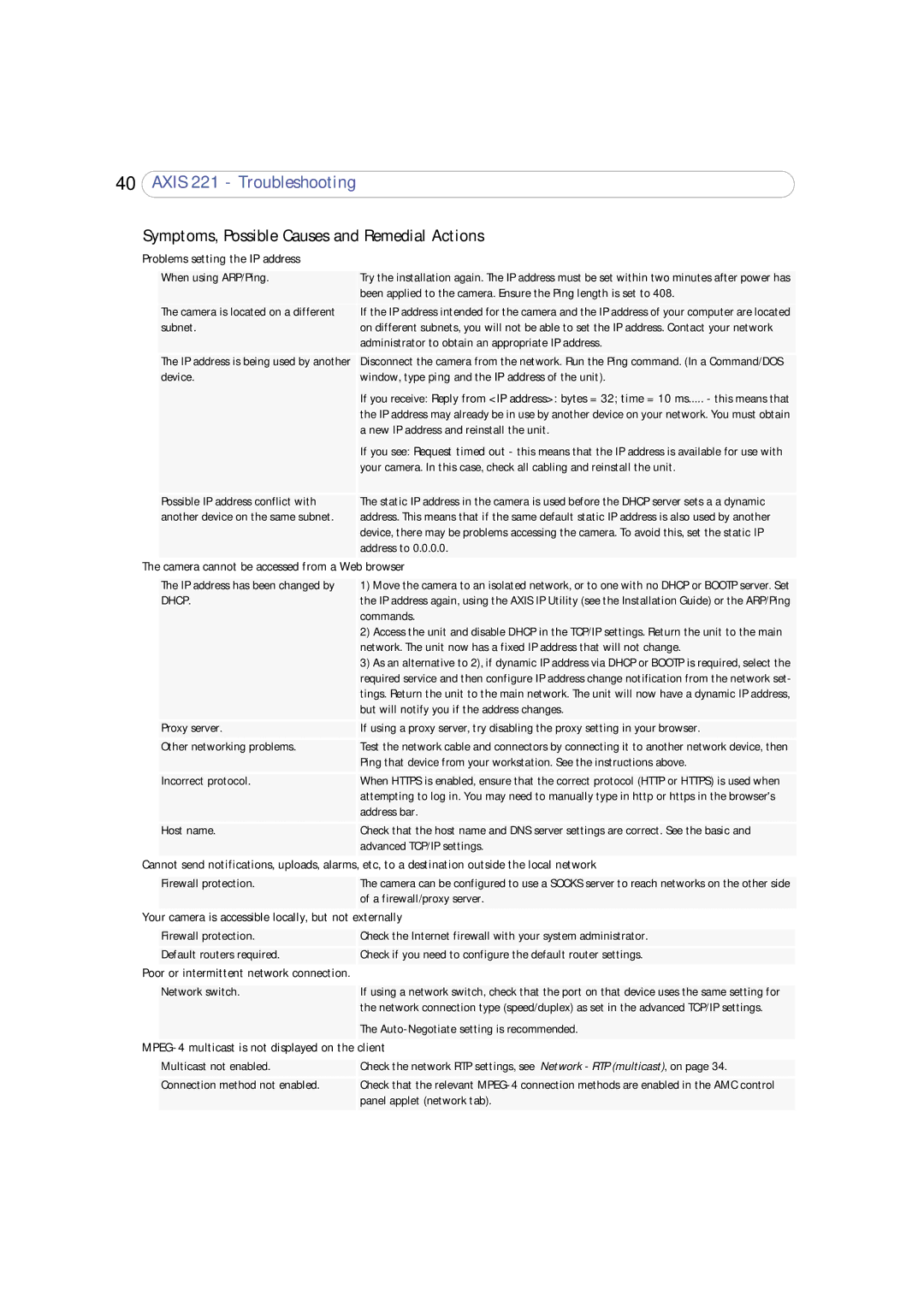
40AXIS 221 - Troubleshooting
Symptoms, Possible Causes and Remedial Actions
Problems setting the IP address |
| |
|
|
|
| When using ARP/Ping. | Try the installation again. The IP address must be set within two minutes after power has |
|
| been applied to the camera. Ensure the Ping length is set to 408. |
| The camera is located on a different | If the IP address intended for the camera and the IP address of your computer are located |
| subnet. | on different subnets, you will not be able to set the IP address. Contact your network |
|
| administrator to obtain an appropriate IP address. |
| The IP address is being used by another | Disconnect the camera from the network. Run the Ping command. (In a Command/DOS |
| device. | window, type ping and the IP address of the unit). |
|
| If you receive: Reply from <IP address>: bytes = 32; time = 10 ms..... - this means that |
|
| the IP address may already be in use by another device on your network. You must obtain |
|
| a new IP address and reinstall the unit. |
|
| If you see: Request timed out - this means that the IP address is available for use with |
|
| your camera. In this case, check all cabling and reinstall the unit. |
| Possible IP address conflict with | The static IP address in the camera is used before the DHCP server sets a a dynamic |
| another device on the same subnet. | address. This means that if the same default static IP address is also used by another |
|
| device, there may be problems accessing the camera. To avoid this, set the static IP |
|
| address to 0.0.0.0. |
The | camera cannot be accessed from a Web | browser |
|
|
|
| The IP address has been changed by | 1) Move the camera to an isolated network, or to one with no DHCP or BOOTP server. Set |
| DHCP. | the IP address again, using the AXIS IP Utility (see the Installation Guide) or the ARP/Ping |
|
| commands. |
|
| 2) Access the unit and disable DHCP in the TCP/IP settings. Return the unit to the main |
|
| network. The unit now has a fixed IP address that will not change. |
|
| 3) As an alternative to 2), if dynamic IP address via DHCP or BOOTP is required, select the |
|
| required service and then configure IP address change notification from the network set- |
|
| tings. Return the unit to the main network. The unit will now have a dynamic IP address, |
|
| but will notify you if the address changes. |
| Proxy server. | If using a proxy server, try disabling the proxy setting in your browser. |
| Other networking problems. | Test the network cable and connectors by connecting it to another network device, then |
|
| Ping that device from your workstation. See the instructions above. |
| Incorrect protocol. | When HTTPS is enabled, ensure that the correct protocol (HTTP or HTTPS) is used when |
|
| attempting to log in. You may need to manually type in http or https in the browser's |
|
| address bar. |
| Host name. | Check that the host name and DNS server settings are correct. See the basic and |
|
| advanced TCP/IP settings. |
Cannot send notifications, uploads, alarms, | etc, to a destination outside the local network | |
|
|
|
| Firewall protection. | The camera can be configured to use a SOCKS server to reach networks on the other side |
|
| of a firewall/proxy server. |
Your camera is accessible locally, but not externally | ||
|
|
|
| Firewall protection. | Check the Internet firewall with your system administrator. |
| Default routers required. | Check if you need to configure the default router settings. |
Poor or intermittent network connection. |
| |
|
|
|
| Network switch. | If using a network switch, check that the port on that device uses the same setting for |
|
| the network connection type (speed/duplex) as set in the advanced TCP/IP settings. |
|
| The |
| ||
|
|
|
| Multicast not enabled. | Check the network RTP settings, see Network - RTP (multicast), on page 34. |
| Connection method not enabled. | Check that the relevant |
|
| panel applet (network tab). |
|
|
|
